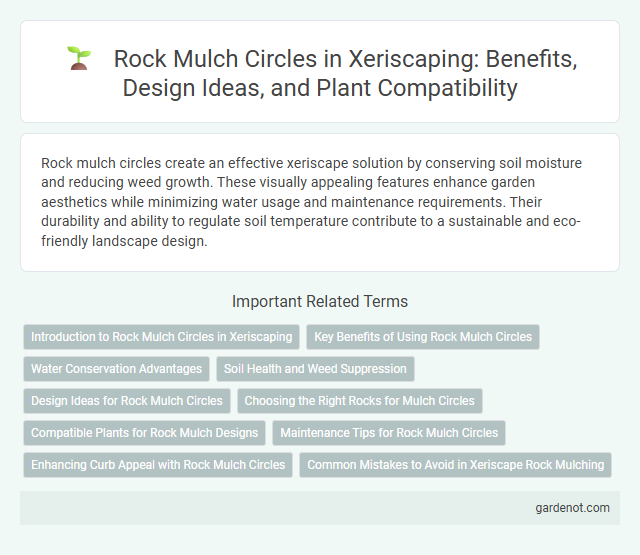Rock mulch circles create an effective xeriscape solution by conserving soil moisture and reducing weed growth. These visually appealing features enhance garden aesthetics while minimizing water usage and maintenance requirements. Their durability and ability to regulate soil temperature contribute to a sustainable and eco-friendly landscape design.
Introduction to Rock Mulch Circles in Xeriscaping
Rock mulch circles are a key element in xeriscaping, providing a durable, low-water landscaping solution that reduces soil erosion and conserves moisture. These circles, often placed around trees or plants, help maintain consistent soil temperature and limit weed growth, enhancing plant health. Using rock mulch in xeriscape designs optimizes water efficiency while adding aesthetic value and structural interest to arid garden spaces.
Key Benefits of Using Rock Mulch Circles
Rock mulch circles conserve soil moisture by reducing evaporation, which supports drought-tolerant xeriscape plants. They suppress weed growth effectively, minimizing maintenance and promoting healthier plant development. Their durability and ability to regulate soil temperature enhance plant resilience in arid landscapes.
Water Conservation Advantages
Rock mulch circles significantly reduce water evaporation by providing a durable barrier that keeps soil moisture intact. This method limits weed growth, decreasing competition for water and enhancing overall water efficiency in xeriscape gardens. Using rock mulch also minimizes the need for frequent irrigation, contributing to sustainable water conservation efforts.
Soil Health and Weed Suppression
Rock mulch circles improve soil health by enhancing moisture retention and reducing erosion around plants. This type of xeriscaping technique suppresses weed growth by blocking sunlight, limiting weed germination and competition. Using rock mulch circles helps create a sustainable, low-maintenance landscape that conserves water and promotes plant vitality.
Design Ideas for Rock Mulch Circles
Rock mulch circles enhance xeriscape gardens by combining aesthetics with water conservation, using varied sizes and colors of stones to create visually appealing patterns. Incorporating drought-tolerant plants like succulents or ornamental grasses within these circles adds texture and focal points while minimizing irrigation needs. Edging with natural materials such as decomposed granite or metal borders defines the circles and prevents mulch displacement, creating a clean, durable design.
Choosing the Right Rocks for Mulch Circles
Selecting the appropriate rocks for xeriscape mulch circles involves considering size, color, and texture to enhance water conservation and aesthetic appeal. Smooth, medium-sized rocks prevent soil erosion and retain moisture more effectively than fine gravel while complementing drought-tolerant plants. Opting for natural, durable stones like lava rock, river rock, or decomposed granite ensures longevity and reduces the need for frequent replacement.
Compatible Plants for Rock Mulch Designs
Succulents, such as agave and sedum, thrive in rock mulch circles due to their low water needs and excellent drainage compatibility. Lavender and ornamental grasses offer drought tolerance and a contrasting texture that enhances xeriscape aesthetics when paired with rock mulch. Native plants like yucca and desert marigold are ideal choices for rock mulch designs, promoting sustainable landscaping with minimal irrigation.
Maintenance Tips for Rock Mulch Circles
Rock mulch circles require minimal watering compared to organic mulch, making them ideal for xeriscape gardens focused on water conservation. Regularly remove debris and weeds by hand or with a leaf blower to maintain the mulch's appearance and prevent invasive growth. Periodically replenish the rocks every 1-2 years to preserve their effectiveness in moisture retention and temperature regulation around plants.
Enhancing Curb Appeal with Rock Mulch Circles
Rock mulch circles create defined, low-maintenance planting areas that enhance curb appeal by adding texture and contrast to landscaping. Using durable, natural stones reduces soil erosion, retains moisture, and suppresses weeds, promoting healthier plant growth. Incorporating rock mulch circles around trees or flower beds offers an attractive, sustainable alternative to traditional organic mulches, elevating the overall aesthetic of any xeriscape design.
Common Mistakes to Avoid in Xeriscape Rock Mulching
Using rock mulch incorrectly in xeriscape can lead to poor water infiltration and soil temperature imbalances, often caused by overly thick layers that prevent moisture absorption. Common mistakes include placing rocks directly on compacted soil without a proper weed barrier, which encourages invasive weed growth and disrupts plant health. Selecting inappropriate rock sizes or colors can also exacerbate heat retention, stressing drought-tolerant plants and undermining xeriscape efficiency.
Rock mulch circle Infographic

 gardenot.com
gardenot.com